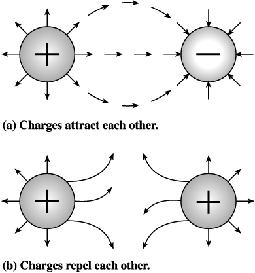Charges and Electric Force
Although
we regularly transfer charges between different
parts of an electric circuit, we do nothing
to change the total amount of charge. Clearly,
we neither create nor destroy electrons
or protons when operating electric circuits.
Moving charges represents an electric
current. In a neutral state (zero
charge), electrons will neither leave nor
enter the neutrally charged body should
it come in contact with other neutral bodies.
If, however, any number of electrons is
removed from the atoms of a body of matter,
there will remain more protons than electrons
and the whole body of matter will become
electrically positive.
Should
the positively charged body come in contact
with another non-charged body, or having
a negative charge, an electric current will
flow between them. Electrons will leave
the more negative body and enter the positive
body. This electron flow will continue until
both bodies have equal charges. When two
bodies of matter have charges and are near
one another, an electric force (F)
is exerted between them.
The
existence of such force, where current does
not flow, is referred to as static.
The force of attraction or repulsion (see
Figure 1.1) exerted between two charged
bodies is directly proportional to the product
of their charges (Q)
and inversely proportional to the square
of the distance (d)
between them.
This relationship between attracting or
repelling charged bodies was first discovered
by a French scientist named
CHARLES A. COULOMB and accordingly
is known as Coulomb’s Law,
which can be expressed mathematically by
the following equation
where
F
is a vector [Focus on Math]
quantity, which represents the electrical
force acting on charge Q2
due to charge Q1
measured in newtons (N)
â
[Focus on Math] is a dimensionless
unit vector with a unity magnitude pointing
from charge Q1
to charge Q2,
and
 0
is a universal constant called the electrical
permittivity of free space 0
is a universal constant called the electrical
permittivity of free space
[
 0
= 8.854 × 10-12 farad per
meter (F/m)]. 0
= 8.854 × 10-12 farad per
meter (F/m)].
The
two charges are assumed to be in free space
(vacuum) and isolated from all other charges.
Note: the arrows indicate
the direction of the force vector F.

Figure
1.1 The force of attraction or repulsion
|